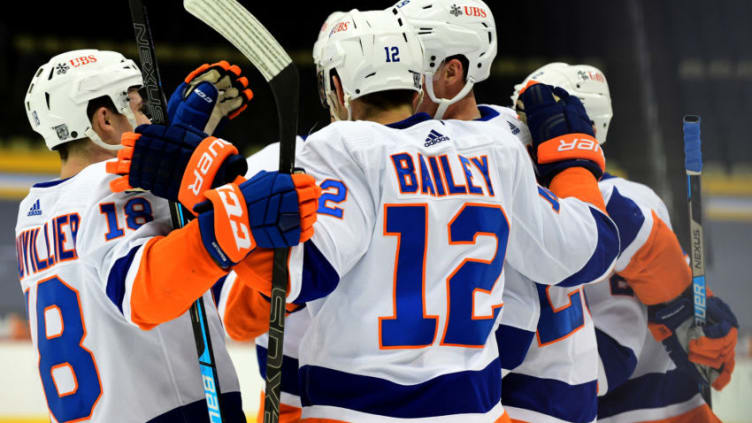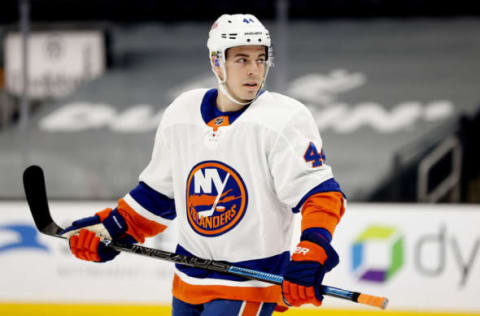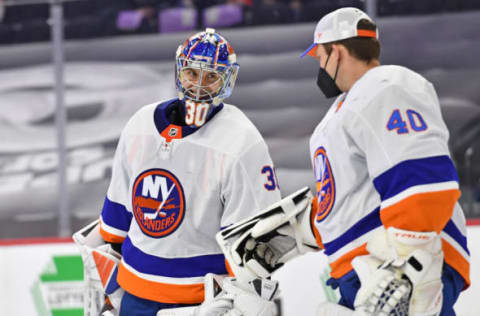Islanders: Three Takeaways from Game 1 Win over Pittsburgh


The New York Islanders needed a gutsy late effort to come from behind and win Game One of their first-round playoff series in Pittsburgh.
The New York Islanders needed a big third period in order to come back and win game one of their opening-round playoff series against the Pittsburgh Penguins. They got that big period and then some, as they take an important win on Pittsburgh ice.
Here are three takeaways from game one.
1. A Strong Showing from Pageau, Palmieri, the Islanders Bottom Nine Forwards
The Islanders top line of Leo Komarov, Mathew Barzal, and Jordan Eberle was mostly quiet on Sunday. None of the three first-line forwards appeared on the scoresheet in game one, but that was made up for by a strong performance from J-G Pageau and the rest of the Isles forwards.
According to Natural Stat Trick, the Islanders bottom-six forward group outshot the Penguins at 5v5 20-13. That bottom six group featured two of the best players in game 1 – Pageau and Kyle Palmieri – who tallied two goals on the day including the OT winner.
Hockey Stat Cards has Pageau and Palmieri listed as the top two players from both teams on the Game Score list. Game Score is a catch-all metric used to quantify a player’s overall performance. Hockey Stat Cards uses the Game Score formula created by The Athletic’s Dom Luszczyszyn.
The Islanders line of Palmieri – Pageau – Wahlstrom were particularly strong, as they controlled more than 60% of total and unblocked shot attempts at 5v5. They took home over 59% of Expected Goals, (xGF%) and scored three actual goals combined to power the New York offense.
The Islanders fourth line, a group that faced its fair share of struggles during the regular season, had a strong game one by throwing the body, forechecking well, and playing well in their own zone.
Casey Cizikas and Cal Clutterbuck in particular saw lots of time on what was a very good Islanders penalty kill. But Pageau and Leo Komarov were every bit as good there too, which resulted in an Isles PK that killed all three penalties they faced, and limited Pittsburgh’s scoring opportunities well.
Palmieri probably saw the best chance to score that the Islanders had on their four-minute power-play in the second period, and despite failing to convert, that was one of the lone bright spots for that New York man-advantage unit.

2. The downside of Game One – The Slow Start and the Power Play
The Islanders first and second-period performances did not go a long way toward assuring anyone that their end-of-season slide had been merely an aberration. New York afforded far too many high-quality looks to the Penguins in the opening frame and had barely any of their own.
#Isles first period stats (5v5, S&V Adj., via NST)
— Ryan Grosso (@Ry_Gro) May 16, 2021
//39.42 FF%
//24.58 SCF%
//16.34 HDCF% (1.07 - 5.45)
//29.72 xGF%
As my tweet above shows, the Islanders took only 39.4% of the unblocked shot attempts during the opening frame. Less than a quarter of scoring chances belonged to New York, with the high-danger chances being even more lopsided towards Pittsburgh’s favor.
As a result, the Isles unsurprisingly ended up with less than 30% of the xG share from the opening 20 minutes of Game One action.
The second period saw gradual improvement from the Islanders, though that was only after the midway point of the frame. The opening ten minutes of the middle frame were similar to the first period.
#Isles second period stats (5v5, S&V Adj., via NST)
— Ryan Grosso (@Ry_Gro) May 16, 2021
//49.72 FF%
//42.7 SCF%
//41.91 HDCF% (2.07 - 2.87)
//43.51 xGF% (.36 - .47)
Sloppy transitional play, too many turnovers, and poor defensive coverages earmarked the opening ten minutes of the second period for New York. However, their play did pick up from that point, and the period’s overall stats reflect that more so than the eye test did, for me at least.
The peak of futility in that period was the Islanders abysmal display on the man advantage. With Jeff Carter in the penalty box for high-sticking Brock Nelson for four minutes, the Islanders mustered barely any threatening offense.
As previously stated, Palmieri’s look at the net from the inner slot was the most dangerous moment of the Islander power-play, and it did not convert. Pittsburgh would clear the zone shortly thereafter, and the Islanders complete inability to enter the zone with control of the puck doomed the rest of the power-play.
The Islanders at 5v4 have been a mess for most of 2020-21. The team saw a brief run of success on the man advantage early in the month of March, but following Anders Lee’s injury that success just seemed to melt away. It’s a problem New York has struggled with for Barry Trotz’s entire reign, and it isn’t likely to be fixed in the span of this playoff run.
What can likely be fixed though is the way the Islanders play early in games. The team simply cannot afford to give away periods as they did the first and second going forward. That isn’t a new trend for Trotz’s team, but it’s one that needs to be bucked ASAP for this group to see a long and successful playoff run.

3. Ilya Sorokin’s Performance, Semyon Varlamov’s Continued Absence
Ilya Sorokin turned aside 39 of 42 Pittsburgh shots to earn his first-ever Stanley Cup Playoffs win. The Islanders game one starter played well enough to earn his team the victory, and that’s all he needed to do.
Sorokin did appear to struggle with his rebound control at times throughout this game. He wasn’t perfect, though I wouldn’t say that any of the three Penguins goals were his fault either.
Sorokin finished by saving .3 goals below expected (GSAx) on the night, according to Natural Stat Trick, though that number doesn’t necessarily reflect some of Ilya’s brighter moments in game one. He made a diving split save to keep the Isles in it, and he limited his mistakes, for the most part, that’s a good sign for a playoff debutant goaltender.
There were some tense moments however after Adam Pelech was dumped at the side of the net by Bryan Rust and fell directly on top of Sorokin’s back. The Isles and Penguins scrum behind the New York net, and Sorokin lay still in the crease in what felt like it could’ve been a series-altering moment.
Thankfully, Sorokin was okay, and the Islanders didn’t need to call upon the services of Cory Schneider, who hasn’t seen any game action all season long outside of two appearances with AHL Bridgeport.
It does however beg the question of when Semyon Varlamov will return to action. Varly was injured in the Islanders final regular-season game at Boston and did not return for the final period of that game. Since then he’s begun practicing with the team, as confirmed by Barry Trotz, but he was absent from the Islanders game one lineup.
Having Varlamov back for the Islanders would be an obvious boost to confidence for the fans, and probably for the team as well. It’s not that Ilya Sorokin was bad in game one. Not at all. It’s just the security of knowing that should something happen to the Islanders starter going forward, another NHL-caliber goaltender could take his place.